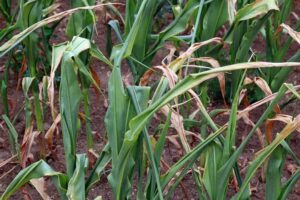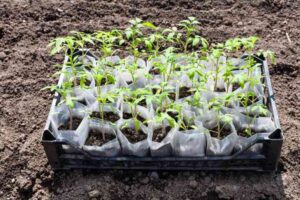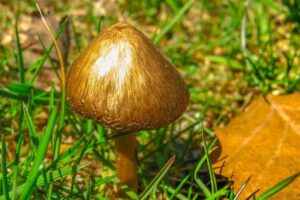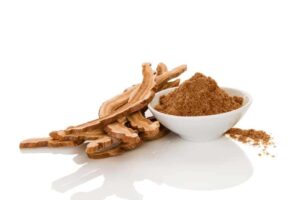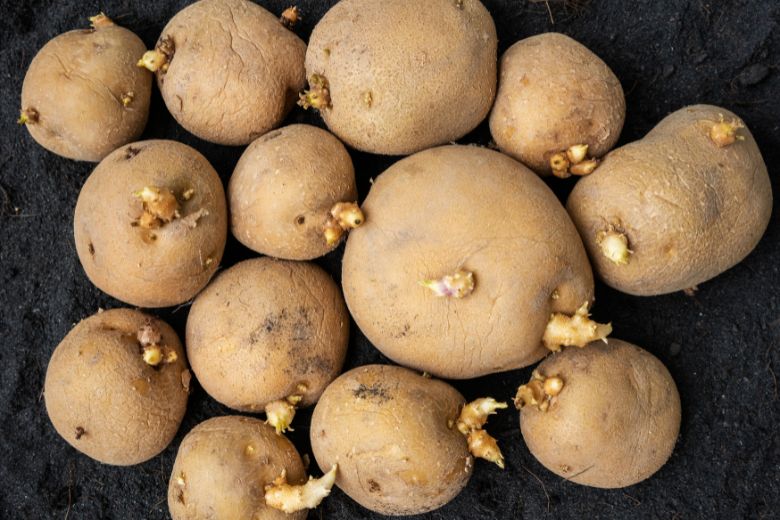
Did you know that potatoes actually produce small seeds that can be collected and planted to grow new potato plants? If you’re interested in saving potato seeds from your garden harvest to plant new potato crops, you must know how to store potato seeds to ensure high germination rates.
However, potato seeds, also known as true potato seeds, must be dried, cleaned, and stored under specific conditions to maintain their ability to germinate over winter and for future seasons. Today, you will walk through the best methods for drying, packaging, and storing potato seeds to maximize viability.
Continue reading to gather knowledge.
Selecting the Right Potato Seeds
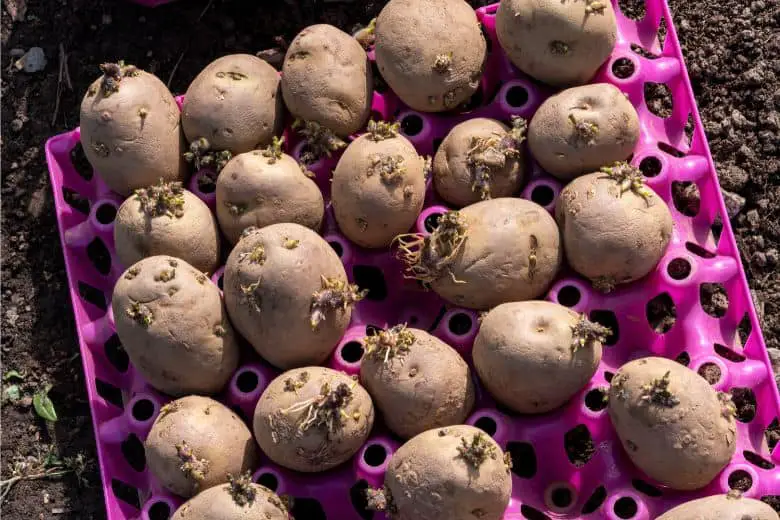
The first step is selecting the right potato tubers to save as seeds.
- Evaluate each potato plant and select tubers only from the most vigorous, productive, and pest-resistant specimens. Avoid unhealthy or stressed plants.
- Examine each potato tuber individually for any signs of damage, cracks, splits, soft spots, or disease. Discard any tubers that are not intact and healthy.
- Do not select tubers that have already sprouted while still on the plant. Sprouted potatoes have a higher risk of rotting in storage.
- Choose tubers that are of a uniform size, measuring at least 1.5 to 2 inches in diameter. Larger tubers will store better and produce a higher yield.
- Save only the largest, highest quality tubers for use as seed potatoes. Use any smaller “baby” potatoes for eating instead of replanting.
- Handle selected seed tubers gently and store them separately from eating potatoes to avoid accidental planting of inferior stock.
- Clearly label stored seed potatoes with the variety and date for future reference.
- Potatoes are a nutritious, versatile, and easy-to-grow crop. Knowing how to select the right potato seed is key to a successful harvest.
The best potato seed is certified by the American Seed Trade Association (ASTA) or another certifying agency. And it should be firm, smooth, and free from any blemishes or disease. When buying potato seed, check the expiration date to make sure the seed is viable.
Curing Potato Seeds
After harvesting, potato seeds need to go through a curing process before long-term storage. Curing helps the tuber skins harden so they are less susceptible to moisture loss, rot, and damage.
# Spread the selected potato seeds out in a single layer in a warm, dry, well-ventilated area like a shed floor or garage for 10-14 days.
# During this time, allow the skin to dry and harden thoroughly. Check the tubers periodically and rotate them to ensure even curing.
# Avoid direct sunlight, which can cause the potatoes to turn green, a condition called chlorosis, which lowers nutrition and growth potential.
How to Store Potato Seeds ( 3 Different Methods)
After curing potato seeds, the real process of storing starts. Here, we have included two methods that have a look at which one you prefer.
1. Initial Seed Storage
Once cured, potato seeds can be moved into initial storage conditions until it’s time to plant in spring. Ideal storage conditions include temperatures around 55-60°F and high humidity levels around 85-95%. A basement or root cellar provides excellent natural storage.
If no such space is available, a sheltered garage or shed can work for the short winter storage period. Place tubers in a labeled breathable container like a burlap or mesh bag in a single layer.
Essentially, the goal is to keep the seeds cool and humid without any freezing temperatures, which can damage them. Check stored potatoes periodically for signs of rot or sprouting, and remove any affected tubers.
2. Long-Term Seed Storage
If storing seeds for over 6 months until the next planting season, extra care needs to be taken to provide optimal longer term storage conditions. The ideal storage temperature range is 40-50°F with high humidity, around 90%.
Freezing must be avoided. Commercial seed potato storage often uses temperature and humidity-controlled rooms. For home gardeners, a refrigerator or cellar is preferable, provided temperatures can be maintained above freezing.
Place seeds in mesh or burlap bags and store them in trays, crates, or bins to allow for air circulation. Adding a shallow layer of damp peat moss, vermiculite, or sand to the tray can help maintain high humidity levels inside storage.
Check potatoes regularly and remove any rotting seeds. Reroute new sprouts by bending them gently without breaking them to encourage dormancy.
Rotating stored seeds every few months prevents moisture build-up on the bottom layers. Seeds stored between 40-50°F for 6-9 months can be successfully planted the next spring if rotting is prevented.
3. Special Storage for Heirloom Varieties
Heirloom potato varieties that gardeners wish to keep true to type over generations may require extra steps to preserve genetic integrity during storage. These rare and often open-pollinated varieties carry valuable genetic traits worth conserving.
Storing heirloom seeds in breathable containers enclosed in a sealed bag protects them from accidental cross-pollination with other varieties during storage.
Clearly, labeling varieties is also important. Storing seeds of heirloom types at the cooler end of the temperature range, around 40-45°F, encourages dormancy over 6-12 months while retaining seed viability for the next season.
Seed Potato Chitting
For home gardeners in very cold climates with short growing seasons, an additional seed potato chitting or sprouting phase can help get a head start on the growing season. 2-to 4 weeks before the anticipated last spring frost date, pull ears out of storage and allow them to naturally chit or sprout in a light-ventilated area at around 60-65°F.
This mimics natural environmental cues potatoes experience to break dormancy and enables planting once the danger of frost has passed. Sprouts will also form a hardened protective sheath that is better able to survive initial field conditions compared to direct-from-storage seeds.
Monitoring Seed Potato Health
Vigilance is important when storing potatoes long term. Careful monitoring prevents disease issues. Check seeds periodically for mold growth, rot, shriveling, or premature sprouting, which signals unsuitable storage conditions that are damaging to seed quality.
Discard any deteriorating seeds immediately to avoid the spread of mold or rot to healthy tubers. Rotate and rerack seeds regularly to ensure uniform environmental exposures and check for variations throughout storage that may require adjustments to temperature or humidity levels. Maintaining optimal seed potato health leads to maximum yields the following season.
Here are some key points about storing potato seeds (also called “seed potatoes” or potato tubers) in different environments:
- Cool and dark: Potatoes need cool temperatures between 40-50°F and high humidity (80-90%) to store well. Darkness helps prevent greening and sprouting. A cellar, garage, or unheated basement is ideal.
- Avoid light and heat: Exposure to light causes potatoes to turn green from solanine alkaloid production. High heat above 55°F can cause sprouting and shriveling.
- Separate from ripening fruits/veggies: Potatoes give off gases that can speed the ripening of other produce. Store separately.
- Ventilation matters: Good air circulation is important to prevent rot. Don’t seal potatoes in an airtight container.
- Don’t refrigerate: Chilling below 40°F can permanently damage potatoes and cause cold-induced sweetening.
- Avoid freezing temperatures: Below 32°F, potatoes can freeze and become waterlogged or develop low quality when cooked.
- Disease-free storage area: Be sure the storage area is cleaned and sterilized to avoid introducing potential bacterial or fungal diseases.
- Temperature fluctuations are ok: Gradual daily temperature swings don’t harm potatoes as much as abrupt changes.
- Controlled humidity: High humidity aids in keeping potatoes from shriveling, but too wet can cause rot.
The key is providing cool, dark, humid conditions with good airflow to optimize potato storage until planting season. Different microclimates in cellars, sheds, etc., provide natural environments for overwintering seed potatoes.
Troubleshooting Common Storage Issues
Modern technology has made it easier than ever for us to store data and information, but with that comes the challenge of troubleshooting common storage issues that can arise. Here are some tips for troubleshooting common storage issues:
- Cut off sprouts with a knife without damaging the tuber. Sprouting indicates they are too warm. Check storage environment and ventilation.
- Discard any greened potatoes. Greening occurs when potatoes are exposed to light and produce toxic solanine alkaloids. Improve storage container darkness.
- Sign of dehydration from inadequate humidity or temperature fluctuations. Check humidity levels are 80-90%.
- A sign of bacterial or fungal disease. Discard any soft or rotting potatoes. Clean and sanitize the storage area thoroughly before replenishing.
- Too much humidity can encourage rot. Improve ventilation and air circulation in storage.
- Potatoes frozen solid will be mealy or cracked when cooked. Check temperature is above freezing (32°F).
- Cold-induced sweetening occurs below 40°F and makes potatoes unsuitable for replanting. Manage temperatures carefully.
- Sign of pests in the storage area. Clean thoroughly and use pest control as needed. Seal any entry points.
- Indicates temps swings too high (above 55°F). Maintain consistent cool temperatures.
Conclusion
Following best practices for curing, storing, and monitoring harvested potato seeds is essential to ensure high germination rates and productivity when planting them to regenerate the next potato crop. With careful attention to storage conditions like temperature, humidity, and ventilation, home gardeners can successfully save their own seeds year after year, preserving treasured potato varieties for many growing seasons to come while saving costs.
Proper seed potato storage is a key component of the potato lifecycle and maximizes the rewards of seed saving for home food production.


